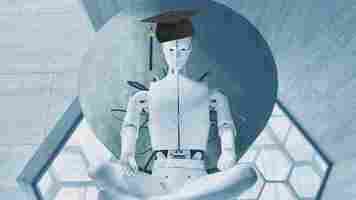EA hypes new AI tech in FIFA 22, but I expect another glorified update
If Euro 2020 broke your heart, EA is offering a rebound relationship: a new edition of FIFA with an AI-powered gameplay overhaul.

The gaming giant is heavily plugging the so-called “HyperMotion” tech, which uses motion capture and machine learning to generate new graphics.
The system was unveiled on Sunday in a shaky cam trailer for FIFA 22, which is out on October 1.
HyperMotion integrates motion capture of 22 professional footballers playing at high intensity. An algorithm learns from almost 9 million frames of capture footage to write new gameplay animations in real-time.
EA describes the system with the usual word salad of bold promises and buzzwords. HyperMotion, the company says, is “revolutionizing football gameplay,” and “ unlocking the raw emotion, passion, and physicality of the world’s game .” The system is also apparently “powered by football,” rather than, say, cricket or marshmallows.
EA claims the system makes FIFA “more realistic and immersive than ever.” But as someone who’s been repeatedly disappointed by the franchise, I doubt that it will live up to the hype.
Now in its 29th edition, FIFA has become little more than an expensive annual upgrade.
At times, EA doesn’t even bother pretending they’ll be different. Take the FIFA 21 Legacy Edition for Switch, for example. The company said the game “will feature the same gameplay innovation from FIFA 20 without any new development or significant enhancements.”
Essentially, the game was a $60 dollar roster update.
HyperMotion at least promises something new, but the gameplay footage shared by EA is distinctly unimpressive. It looks like the algorithm was trained on a team of crabs.
Some gamers won’t even get the revamp: HyperMotion is only available on PS5, Xbox Series X/S, and Stadia.
In another kick in the teeth of FIFA fans, EA will only offer a free next-gen upgrade to people who buy the $99.99 “Ultimate Edition” of the game.
Perhaps I’m being unfair; maybe HyperMotion really will “revolutionize football gameplay.” But I suspect that it’s more about marketing than substance.
As an incorrigible FIFA addict, I’ll probably end up buying the game again this year — and thereby encourage EA to repeat the same trick next time. At least I might be able to win something with England.
Greetings Humanoids! Did you know we have a newsletter all about AI? You can subscribe to it right here .
This bizarro AI creates psychedelic visual interpretations of famous poems
Poems are one of the favorite topics to explore for AI researchers. Google built one to help you compose poetry that doesn’t look like you shat words on paper, Microsoft built one to convert images into Chinese poetry , and OpenAI’s GPT-3 helped you correct the grammar of your sad prose .

However, this new video created by computer artist and animator Glenn Marshall uses AI to narrate and create visualizations for poems. It’s based on the poem ‘In the Bleak Midwinter’, written by an English 19th-century writer Christina Rossetti.
The visualizations are striking in a slightly disturbing way. They are not the most sophisticated animations, but rather low-res GIFs. It almost reminds me of band Storm Corrosion’s video for their dark song ‘Drag Ropes.’
Marshall has used the Story2Hallucination library to convert words into the video. It’s interesting to see some parts of the video interpreting words of the poem in a literal sense. For instance, you’ll see a stone emerge from the water to signify “water like a stone.”
For narration, the video uses the voodes tool to borrow Christopher Lee’s voice.
Creating visualizations from text is growing as a use case for AI models. Last month, OpenAI revealed a new library called DALL-E that converts words and phrases into images. It would be fascinating to see when poets and writers get access to tools that let them choose from a range of AI models to transform their writings into videos.
AI must have its own goals to be truly intelligent
Welcome to AI book reviews , a series of posts that explore the latest literature on artificial intelligence.

What is intelligence? Is it the capacity to solve complicated mathematical problems at very fast speeds? The power to beat world champions in chess and go? The ability to detect thousands of different objects in images? Predict the next word in a sentence?
Those are all manifestations of intelligence. And thanks to advances in artificial intelligence, we have been able to replicate them in computers, to different degrees of success. But AI scientists are still having a hard time reaching a consensus on the definition and measure of intelligence. And having a collection of problem-solving capabilities does not seem to get us closer to recreating the intelligence found in nature.
To Daeyeol Lee, professor of neuroscience at Johns Hopkins University, current AI systems are “surrogates of human intelligence” because they are designed to accomplish the goals of their human creators, not their own.
True intelligence, Lee argues in his book Birth of Intelligence: From RNA to Artificial Intelligence , is “the ability of life to solve complex problems in a variety of environments for its self-replication.” In other words, every living species that has passed the test of time and has been able to reproduce—from bacteria to trees, insects, fish, birds, mammals, and humans—is intelligent.
“[If] we want to evaluate the intelligence of various life forms, it would be reasonable to consider which life form can replicate itself successfully by solving more complex problems in a broader range of environments,” Lee writes.
Looking at intelligence through the lens of life and survival is crucial to understanding the current state of artificial intelligence, including its limits, its potential, and its future directions.
Genetic intelligence
Life is a race against death. From birth, every organism faces dangers from its environment, whether they appear as scarcity of food, sudden changes in the weather, other organisms that prey on it or compete with it for resources, or the simple passage of time.
Organisms that live long enough—whether by being better equipped to survive in their environment or through sheer luck—get to reproduce and pass on their genes to their descendants. Their offspring do not inherit perfect copies of their genes. They have slight differences, also called mutations. Sometimes, these mutations enhance the capabilities that are crucial to survival and improve the chances of reproduction. Eventually, after millions of cycles of reproduction and mutation, the species evolves to enhance its capabilities and develop new organs that improve its response to the conditions imposed by the environments.
Otherwise put, its descendants become more intelligent because they are better survivors and self-replicators.
In single-cell organisms and plants, intelligence is derived from taxis and tropisms, static behavior directly encoded in the genes. Taxis and tropisms enable organisms to respond to different stimuli in their environment, such as turning to face light sources or moving toward locations where food sources are denser.
In these organisms, genes are in full control of behavior, and intelligence depends on genetic evolution.
Brain intelligence
More complex organisms, such as animals, have developed brains and nervous systems, which provide them with more diverse and complicated patterns of behavior.
The nervous system has reflexive behaviors, such as instinctive responses to pain and threatening noises. But its greatest advantage is the capacity to learn. Animals with brains learn by interacting with their environment adjusting their behavior to favor actions that maximize their rewards. This is also calledreinforcement learning.
Learning makes organisms more intelligent and enables them to change their behavior during their lifetime. Compared to single-cell organisms, animals are better at responding to changes in their environments, and they don’t need to wait for several generations of mutations before behavioral changes are baked into the genes of their descendants. They can develop very complicated and dynamic behaviors such as creating shelters for themselves, hunting, taking care of their young, and socializing.
Intelligence in animals with brains and nervous systems can be seen as two concentric loops. The outer loop is genetic evolution, the slow enhancement of the species’ body and limbs across generations. The inner loop is fast learning, the skills that each organism acquires throughout its lifetime.
There are synergies between the two kinds of intelligence. The brain serves the genes by improving the organism’s capability to survive and reproduce. In exchange, evolution favors genetic mutations that improve the brain’s innate and learning capacities for each species (this is why some animals are born with the ability to walk while others learn it weeks or months later).
At the same time, the brain comes with tradeoffs. Genes lose some of their control over the behavior of the organism when they relegate their duties to the brain. Sometimes, the brain can go chasing rewards that do not serve the self-replication of the genes (e.g., addiction, suicide). Also, the behavior learned by the brain does not pass on through genes (this is why you didn’t inherit your parents’ knowledge and had to learn language, math, and sports from scratch).
As Lee writes in Birth of Intelligence, “The fact that brain functions can be modified by experience implies that genes do not fully control the brain. However, this does not mean that the brain is completely free from genes, either. If the behaviors selected by the brain prevent the self-replication of its own genes, such brains would be eliminated during evolution. Thus, the brain interacts with the genes bidirectionally.”
Takeaways for artificial intelligence
The AI community usually turns to the brain to get inspiration for algorithms and new directions of research. Scientists try to replicate the cognitive functions of the brain and the nervous systems in computers.
But the evolutionary view of intelligence shows us that the brain, with all its wonders and unlocked secrets, is a product of the long-lived history of genetic evolution. It is an agent of the gene, albeit one that is very complicated and at times beyond the control of its principal.
“Present-day AI is still not truly intelligent, not because it is made of materials and building blocks that are different from those of the human brain, but because it is designed to solve the problems chosen by humans,” Lee writes. “If AI is truly intelligent, it must have its own goals and seek solutions to any problems for its own sake. AI is built to improve the well-being and prosperity of human beings rather than its own.”
Seen in this light, AI—at least in its present form—is an extension of human intelligence, just like brains are an extension of genetic intelligence. Our AI algorithms can do billions of computations in a second and learn to do things that would be beyond the capacity of the human brain. But they are still designed to solve known problems that human brains have discovered and formulated. And our brains are the agents of our genes. You can think of AI as a third loop in the intelligence graph. It evolves much faster than intelligence and organic learning, but is still bound by constraints set by its outer loops.
This does not mean AI will not harm people. There are already plenty of examples where AI systems are causing harm . But it is not the work of a runaway AI that is actively scheming to hurt humans. These mistakes are the result of faulty AI systems designed and misused by humans.
What about the narrow AI systems that are defeating StarCraft champions , matching humans in image classification, and performing real-time speech recognition? Are they threatening human existence?
No, Lee argues, because the goal of these narrow AI systems is to tackle problems that are impossible or hard to solve for humans. Otherwise, they would have no use.
“[Competition] between AI and human performance is not a threat to human society, but rather a necessary condition for AI,” he writes. “Brains evolved as sophisticated learning machines, and this was a solution, not a threat, to the principal-agent relationship between brains and genes. Similarly, advances in AI technology itself would not pose a threat to humans.”
Therefore, AI that does not develop its own goals and utilities will remain one of the many tools that humans have invented to increase the efficiency of their labor.
“As long as computers do not physically reproduce themselves, humans will remain the principal and control the behaviors of computers with AI, just like the brain is unable to replicate itself and, as result, continues to function as an agent for the genes,” Lee writes.